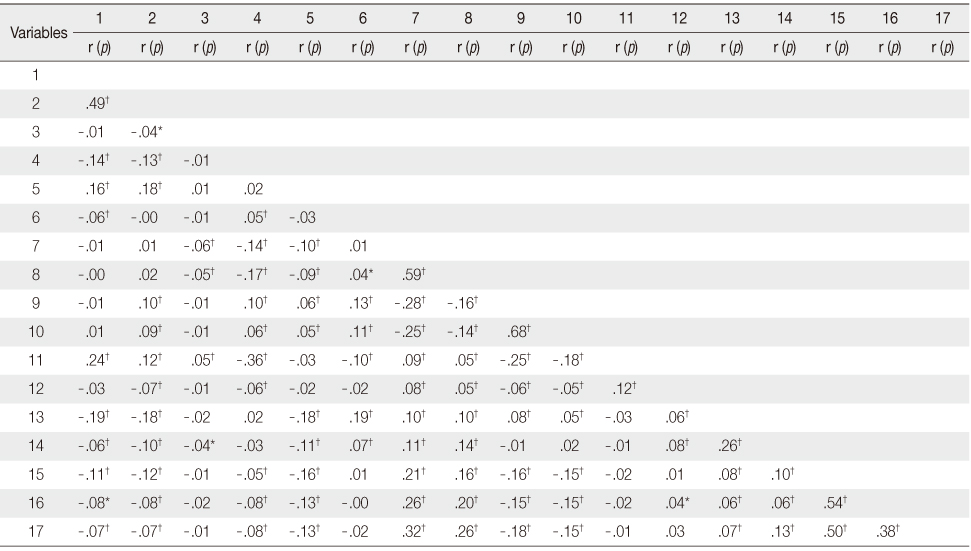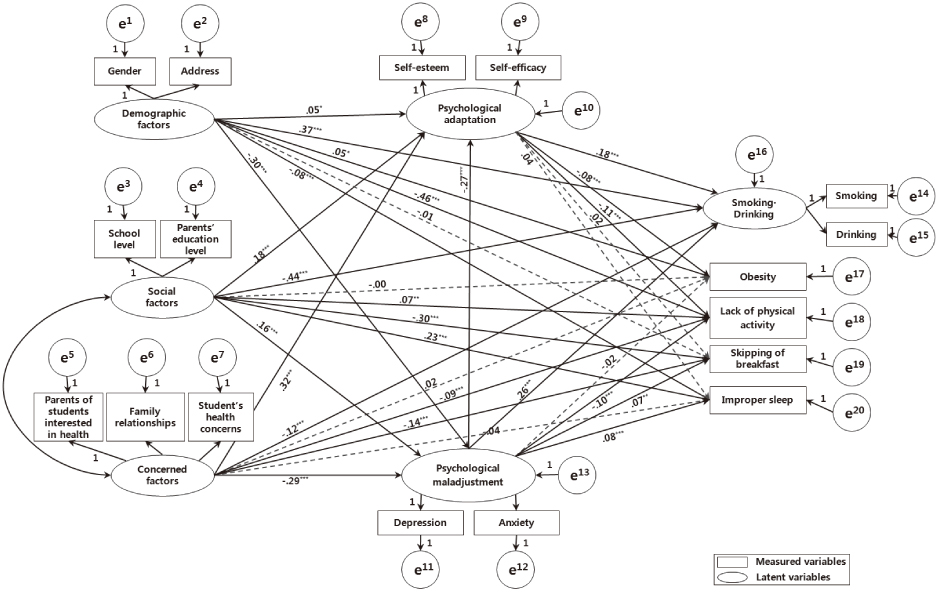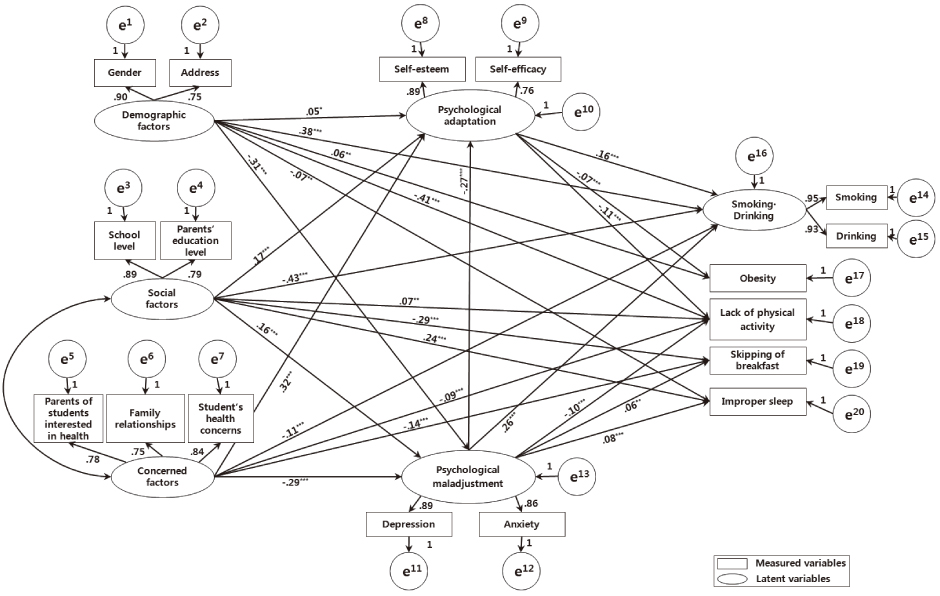Articles
- Page Path
- HOME > J Korean Acad Nurs > Volume 44(2); 2014 > Article
-
Original Article
- A Structural Model for Health Risk Behavior of Late Adolescents: Based on 2010 Korea Adolescent Health Survey
- Young-Ju Jee, Young-Hae Kim
-
Journal of Korean Academy of Nursing 2014;44(2):179-188.
DOI: https://doi.org/10.4040/jkan.2014.44.2.179
Published online: April 30, 2014
1Department of Nursing, Kyungnam University, Changwon, Korea.
2College of Nursing, Pusan National University, Busan, Korea.
- Address reprint requests to: Kim, Young-Hae. College of Nursing, Pusan National University, 49 Busandaehak-ro, Mulgeum-eup, Yangsan 626-870, Korea. Tel: +82-51-510-8305~7, Fax: +82-51-510-8308, ungaekim@pusan.ac.kr
© 2014 Korean Society of Nursing Science
This is an Open Access article distributed under the terms of the Creative Commons Attribution NoDerivs License. (http://creativecommons.org/licenses/by-nd/4.0/) If the original work is properly cited and retained without any modification or reproduction, it can be used and re-distributed in any format and medium.
Abstract
-
Purpose
- This study was done to construct and test a structural model to explain health risk behavior of late adolescents.
-
Methods
- Data for this study were secondary data from the 2010 Korea Adolescent Health Survey based and 3,675 high school students who participated. Data were analyzed using SPSS 18.0 and AMOS 19.0 programs.
-
Results
- After 7 lines were removed, fitness statistics for the hypothetical model were appropriate (χ2=559.13, p<.001, GFI=.98, SRMR=.03, RMSEA=.04, NFI=.88, IFI=.90, CFI=.90, TLI=.86, AIC=671.13). The result showed that drinking-smoking is directly affected by 5 variables (32.5%), obesity is directly affected by 2 variables (0.7%), lack of physical activity is directly affected by 5 variables (22.2%), skipping of breakfast is directly affected by 3 variables (11.9%), improper sleep is directly affected by 3 variables (7.5%), and psychological adaptation is directly affected by 4 variables (26.8%).
-
Conclusion
- The results of this study, indicate that late adolescents' health risk behavior is affected by many factors with complicate correlations suggesting further study compare youth health risk behaviors in a variety of environments.
This manuscript is based on a part of the first author's doctoral dissertation from Pusan National University.
- 1. Belloc NB, Breslow L. Relationship of physical health status and health practices. Prev Med. 1972;1(3):409–421.ArticlePubMed
- 2. The National Youth Policy Institute. Korean youth indicator survey V: Health and safety (protection) [Internet]. Seoul, The National Youth Policy Institute. 2010;cited 2012 December 31. Available from: http://118.128.24.6/pdfs/2010/11.pdf
- 3. Mun YH. A survey on health promoting behavior and its related factors for high school students. J Korean Community Nurs. 2001;12(1):81–91.
- 4. Park NH, Lee HJ. A critical review of health behavior studies of adolescents conducted in Korea. J Korean Community Nurs. 2002;13(1):98–114.
- 5. Jessor R, Jessor SL. Problem behavior and psychosocial development: A longitudinal study of youth. New York, NY: Academic Press; 1977.
- 6. Irwin CE Jr, Millstein SG. Biopsychological correlates of risk-taking behaviors during adolescence: Can the physician intervene? J Adolesc Health Care. 1986;7:6 Suppl. 82S–96S.PubMed
- 7. Selman RL, Schultz LH, Nakkula M, Barr D, Watts C, Richmond JB. Friendship and fighting: A developmental approach to the study of risk and prevention of violence. Dev Psychopathol. 1992;4(4):529–558. http://dx.doi.org/10.1017/S0954579400004867Article
- 8. Han SC, Kim H, Sull I, Lim Y, Cho AM. Adolescent behavior problems: Psychological approach. Seoul: Hakjisa Publisher; 2003.
- 9. Pender NJ. Health promotion in nursing practice. 3rd ed. Stamford, CT: Appleton & Lange; 1996.
- 10. Naidoo J, Wills J. District Health Study Group. Foundations for health promotion. 3rd ed. Oxford, UK: Elsevier Health Sciences UK; 2009.
- 11. Kim HS. A study on the health of high school students [master's thesis]. Daejeon, Chungnam National University. 1991.
- 12. Torsheim T, Currie C, Boyce W, Kalnins I, Overpeck M, Haugland S. Material deprivation and self-rated health: A multilevel study of adolescents from 22 European and North American countries. Soc Sci Med. 2004;59(1):1–12. http://dx.doi.org/10.1016/j.socscimed.2003.09.032ArticlePubMed
- 13. Feldman AF, Matjasko JL. The role of school-based extracurricular activities in adolescent development: A comprehensive review and future. Rev Educ Res. 2005;75(2):159–210. http://dx.doi.org/10.3102/00346543075002159
- 14. Kim SH, Lee CW, Jeon YH. A survey of the health risk behaviors of some high school students in Taegu. J Korean Public Health Assoc. 2000;26(1):38–45.
- 15. The Korea Alcohol Research Foundation. Korean culture of drinking and prevention of alcohol problems, treatment and rehabilitation. In: The First Founding Anniversary Symposium of the Korea Alcohol Research Foundation; 2011 April 27; Seoul, Korea Press Center.
- 16. Kang S, Kim S, Lee J. Prevalence rates and risk factors of overweight and obesity in children and adolescents: Using Korean national health and nutrition examination survey 2005 data. Korean J Epidemiol. 2008;30(2):188–197. http://dx.doi.org/10.4178/kje.2008.30.2.188Article
- 17. Yoon HM, Park BK. Factors associated with adolescents' problem behaviors. Korean J Soc Welf Stud. 2005;28:133–164.
- 18. Fisher RA, Williams M, da Costa AL, Malhi Y, da Costa RF, Almeida S, et al. The response of an Eastern Amazonian rain forest to drought stress: Results and modelling analyses from a through-fall exclusion experiment. Glob Chang Biol. 2007;13(11):2361–2378. http://dx.doi.org/10.1111/j.1365-2486.2007.01417.xArticle
- 19. Lewis MA, Phillippi J, Neighbors C. Morally based self-esteem, drinking motives, and alcohol use among college students. Psychol Addict Behav. 2007;21(3):398–403. http://dx.doi.org/10.1037/0893-164x.21.3.398ArticlePubMed
- 20. Moon HS, Oh KJ. A validation study of the Korean social anxiety scale for children and adolescents. Korean J Clin Psychol. 2002;21(2):429–443.
- 21. Noh AY, Jeong M. Personality psychology. Seoul: Hakjisa Publisher; 2003.
- 22. Park HS, Jung SY. Predictors of gambling behavior among high school students. J Korean Acad Psychiatr Ment Health Nurs. 2011;20(3):219–232.Article
- 23. Ko YK, Yoo IY, Kang KH, Lim JY, Kim MJ, Yoo HJ. Factors related to high-risk health behavior in middle school adolescents. J Korean Acad Child Health Nurs. 2006;12(3):341–350.
- 24. An JY, Tak YR. Health-risk behaviors and self-efficacy in early adolescents. J Korean Acad Community Health Nurs. 2006;17(3):387–396.
- 25. Korea Centers for Disease Control and Prevention. 2007 Korean national growth charts: Review of developmental process and outlook [Internet]. Cheongwon, Korea Centers for Disease Control and Prevention. 2008;cited 2012 December 31. Available from: http://www.cdc.go.kr/CDC/cms/content/03/12103_view.html
- 26. Kim EJ. A study on familiar factors which effect of dinking and smoking of adolescent [master's thesis]. Cheongju, Cheongju University. 2012.
- 27. Choi J, Kim MY. Factors influencing health risk behavior in high school students. J Korean Acad Child Health Nurs. 2009;15(2):182–189. http://dx.doi.org/10.4094/jkachn.2009.15.2.182Article
- 28. Korea Centers for Disease Control and Prevention. Korea youth risk behavior web-based survey [Internet]. Cheongwon, Korea Centers for Disease Control and Prevention. 2011;cited 2012 December 31. Available from: https://yhs.cdc.go.kr/
- 29. Kantomaa MT, Tammelin TH, Näyhä S, Taanila AM. Adolescents' physical activity in relation to family income and parents' education. Prev Med. 2007;44(5):410–415. http://dx.doi.org/10.1016/j.ypmed.2007.01.008ArticlePubMed
- 30. Lee SH. Comparison on life patterns between academic and vacational high school students [master's thesis]. Suwon, Ajou University. 2003.
REFERENCES

*p<.05; †p<.001; 1=Smoking; 2=Drinking; 3=Obesity; 4=Lack of physical activity; 5=Skipping of breakfast; 6=Improper sleep; 7=Self-esteem; 8=Self-efficacy, 9=Depression; 10=Anxiety; 11=Gender; 12=Address; 13=School level; 14=Parents' education level; 15=Interested in health by parents of students; 16=Family relationships; 17=Student's health concerns.
Figure & Data
REFERENCES
Citations

- Multilevel Factors Associated With Lifetime, Current, and Binge Drinking Among Korean Adolescents Based on the Ecological Model
Eun-Mi Kim, Heejung Kim
Journal of Addictions Nursing.2023; 34(2): 135. CrossRef - A study on the relationship between the experiences of depression, suicidal thoughts, and habitual drugs and oral symptoms in middle and high school students
Ji-Young Park, Jong-Hwa Lee
Journal of Korean Acedemy of Dental Technology.2022; 44(1): 15. CrossRef - Structural relationships among adolescents’ peer attachment, career‐related self‐efficacy, parents’ attitudes and health risk behaviours
Gyu Young LEE, Da Ye LEE
Nursing Open.2021; 8(6): 3315. CrossRef - Factors affecting health risk behaviors, suicidal ideation, suicidal plans and suicidal attempts in adolescents
Min Kyung Kim, Kyoung Won Cho
Korean Journal of Health Education and Promotion.2019; 36(3): 61. CrossRef - Factors influencing the mental health in Korean youth in subjective poverty
Mi Jin Kim, Jeong Hee Jeong
Korean Journal of Health Education and Promotion.2019; 36(5): 53. CrossRef - The Relationship between Smoking and Unhealthy Weight Control Behaviors among Korean Adolescents: The Tenth Korea Youth Risk Behavior Web-Based Survey, 2014
Won Yong Sim, Young Gyu Cho, Jae Heon Kang, Hyun Ah Park, Kyoung Woo Kim, Yang Im Hur, Koh Eun Shin, Gyeong Ran Byeon
Korean Journal of Family Medicine.2017; 38(1): 28. CrossRef - Factors affecting Attempts to Quit Smoking in Korean Adolescents
Jeeyeon Park
Journal of the Korean Society of School Health.2016; 29(3): 277. CrossRef - A Study on the Health Risk Behaviors of Adolescents from Multicultural Families according to the Parents' Migration Background
Jung-Ok Yu, Myo Sung Kim
Journal of Korean Academy of Community Health Nursing.2015; 26(3): 190. CrossRef


Figure 1
Figure 2
Correlation of Variables (N=3,675)
*p<.05; †p<.001; 1=Smoking; 2=Drinking; 3=Obesity; 4=Lack of physical activity; 5=Skipping of breakfast; 6=Improper sleep; 7=Self-esteem; 8=Self-efficacy, 9=Depression; 10=Anxiety; 11=Gender; 12=Address; 13=School level; 14=Parents' education level; 15=Interested in health by parents of students; 16=Family relationships; 17=Student's health concerns.
Validation of Fit Hypothesis Model and the Modified Model
df=degree of freedom; GFI=Goodness of Fit Index; SRMR=Standardized Root Mean Square Residual; RMSEA=Root Mean Square Error of Approximation; NFI=Normed Fit Index; IFI=Incremental Fit Index; CFI=Comparative Fit Index; TLI=Tucker Lewis Index; AIC=Akaike Information Criterion.
*
df=degree of freedom; GFI=Goodness of Fit Index; SRMR=Standardized Root Mean Square Residual; RMSEA=Root Mean Square Error of Approximation; NFI=Normed Fit Index; IFI=Incremental Fit Index; CFI=Comparative Fit Index; TLI=Tucker Lewis Index; AIC=Akaike Information Criterion.
 KSNS
KSNS
 E-SUBMISSION
E-SUBMISSION



 Cite
Cite

